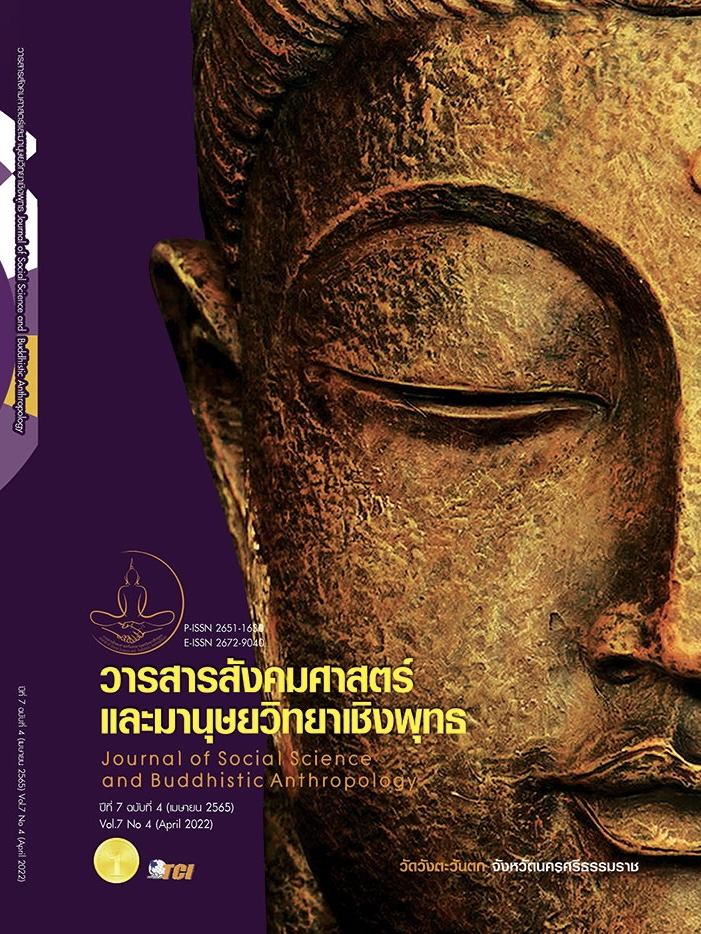THE SUCCESSFUL MANAGEMENT MODEL OF CONSTRUCTION INDUSTRY BUSINESS FOR LARGE CONSTRUCTION PROJECTS IN BANGKOK METROPOLITAN AND VICINITY
Keywords:
Management Model, Contraction Industry Group, Contraction Project, Success FactorsAbstract
The objectives of the research article were to: 1) study the characteristic of successfully contracture industry entrepreneurs, 2) study the characteristic relationship of successful contracture industry entrepreneurs that factors affecting success and also successful management, 3) study the factors that influence the success in the construction industry, and 4) develop the successful management of construction industry. The study was mix research method that including with quantitative questionnaires was used as research tools. Questionnaires were used as research tools and purposive sampling. A sample group of 400 contraction project boards in Bangkok and vicinity. Using statistical analysis by percentage, mean, standard deviation, and multiple regression. The qualitative interview was used as a research tool, purposive sampling. The key informant was 1) chief executive, 2) president, and 3) project manager for all 14 persons, content analysis. The research found that: 1) characteristics of entrepreneurs were found very high level in the overview ( = 4.34), Factors affecting the success of industrial business were found very high level in the overview (
= 4.36), and affecting success and also successful management were found very high level in the overview (
= 4.27). 2) The relationship was characteristic that factors affecting success (R = 0.281-0.652), the successful management (R = 0.326-0.776), and affecting factors that was the result of successful management (R = 0.346-0.661). There was a statistically significant positive relationship at the .01 3 levels. 3) The success factor was entrepreneurial characteristic found positive influence and negative factors affecting success statistically significant at .01, and 4) The model was included with the characteristic relationship of successful contracture industry entrepreneur that factors affecting success and successful management, evaluating the model covering all four aspects such as utilization, feasibility, appropriateness, and comprehensiveness considered that the information obtained was appropriated and also statistically significant at 0.05.
References
กรมส่งเสริมอุตสาหกรรม กระทรวงอุตสาหกรรม. (2560). ผู้ประกอบการยุคใหม่ ทำอย่างไรจึงจะสำเร็จ. กรุงเทพมหานคร: กรมส่งเสริมอุตสาหกรรม กระทรวงอุตสาหกรรม โดยกองส่งเสริมผู้ประกอบการและธุรกิจใหม่.
กิตติพศ กวีสิทธิสารคุณ. (2558). ความสัมพันธ์ระหว่างปัจจัยสำหรับคัดเลือกสัญญาก่อสร้างและผลสัมฤทธิ์ของโครงการก่อสร้าง. ใน วิทยานิพนธ์วิศวกรรมศาสตรมหาบัณฑิต สาขาวิชาวิศวกรรมก่อสร้างและการจัดการ. สถาบันเทคโนโลยีพระจอมเกล้าเจ้าคุณทหารลาดกระบัง.
ข่าวอสังหาริมทรัพย์. (2564). เทคโนโลยี ทางรอดอุตสาหกรรมก่อสร้างไทย. เรียกใช้เมื่อ 1 ตุลาคม 2564 จาก https://baania.com/th/article/เทคโนโลยี-ทางรอดอุตสาหกรรมก่อสร้างไทย
ชลิตา บุญนภา. (2559). คุณลักษณะของผู้ประกอบการและโอกาสของธุรกิจที่มีผลต่อความสำเร็จของผู้ประกอบการธุรกิจวัสดุก่อสร้างในเขตกรุงเทพมหานคร. ใน สารนิพนธ์การศึกษาบริหารธุรกิจมหาบัณฑิต สาขาวิชาบริหารธุรกิจ. มหาวิทยาลัยกรุงเทพ.
ชัยชนะ ชิดช่วงชัย และคณะ. (2561). ปัจจัยที่มีผลต่อความสำเร็จของโครงการก่อสร้างขนาดใหญ่. ใน การประชุมทางวิชาการของมหาวิทยาลัยเกษตรศาสตร์ ครั้งที่ 56: สาขาวิทยาศาสตร์และพันธุวิศวกรรม, สาขาสถาปัตยกรรมศาสตร์และวิศวกรรมศาสตร์, สาขาอุตสาหกรรมเกษตร, สาขาทรัพยากรธรรมชาติและสิ่งแวดล้อม. มหาวิทยาลัยเกษตรศาสตร์.
ธนาคารแห่งประเทศไทย. (2562). การบริหารสินทรัพย์และหนี้สิน. เรียกใช้เมื่อ 25 ธันวาคม 2562 จาก https://www.bot.or.th/Thai/FinancialInstitutions/PruReg_ HB/RiskMgt_Manual/Documents/AssetsLiabilityManagement.pdf
ธเนศ มหัทธนาลัย. (2564). แนวโน้มธุรกิจ/อุตสาหกรรม ปี 2564 - 2566: ธุรกิจรับเหมาก่อสร้าง. เรียกใช้เมื่อ 5 ตุลาคม 2564 จาก https://www.krungsri.com/th/ research/industry/industry-outlook/Construction-Construction-Materials/Construction-Contractors/IO/io-Construction-Contractors-21
บุญชม ศรีสะอาด. (2556). วิธีการทางสถิติสำหรับการวิจัย เล่ม 2. กรุงเทพมหานคร: สุวีริยาการพิมพ์.
ประธานกรรมการ. (22 กันยายน 2563). เรื่องรูปแบบการบริหารจัดการที่ประสบความสำเร็จของกลุ่มธุรกิจอุตสาหกรรมก่อสร้างสำหรับโครงการก่อสร้างขนาดใหญ่ในพื้นที่กรุงเทพมหานครและปริมณฑล. (ศิรัส เคนพะนาน, ผู้สัมภาษณ์)
ผู้จัดการโครงการก่อสร้างขนาดใหญ่. (26 กันยายน 2563). เรื่องรูปแบบการบริหารจัดการที่ประสบความสำเร็จของกลุ่มธุรกิจอุตสาหกรรมก่อสร้างสำหรับโครงการก่อสร้างขนาดใหญ่ในพื้นที่กรุงเทพมหานครและปริมณฑล. (ศิรัส เคนพะนาน, ผู้สัมภาษณ์)
ผู้บริหารระดับสูง. (24 กันยายน 2563). เรื่องรูปแบบการบริหารจัดการที่ประสบความสำเร็จของกลุ่มธุรกิจอุตสาหกรรมก่อสร้างสำหรับโครงการก่อสร้างขนาดใหญ่ในพื้นที่กรุงเทพมหานครและปริมณฑล. (ศิรัส เคนพะนาน, ผู้สัมภาษณ์)
พิชญา มัชฌิมศรัทธา. (2554). บุคลิกการเป็นผู้ประกอบการภูมิความรู้ ความชำนาญ ทักษะการจัดหาทรัพยากรใหม่ และความสำเร็จในการประกอบธุรกิจของผู้ประกอบการโรงแรมอิสระใน เขตกรุงเทพมหานคร. ใน วิทยานิพนธ์ศิลปศาสตรมหาบัณฑิต สาขาวิชาจิตวิทยาอุตสาหกรรมและองค์การ. มหาวิทยาลัยธรรมศาสตร์.
ศูนย์วิจัยกสิกรไทย. (2564). เจาะทิศทางก่อสร้างไทยปี 62. ธนาคารกสิกรไทย. เรียกใช้เมื่อ 14 ตุลาคม 2564 จาก https://kasikornbank.com/th/business/sme/ KSMEKnowledge /article/KSMEAnalysis/Documents/Thai-Construction-Direction_2019.pdf
สำนักงานคณะกรรมการพัฒนาการเศรษฐกิจและสังคมแห่งชาติ. (2560). แผนพัฒนาเศรษฐกิจและสังคมแห่งชาติ ฉบับที่ 12 (พ.ศ. 2560 - 2564). กรุงเทพมหานคร: สำนักงานคณะกรรมการพัฒนาการเศรษฐกิจและสังคมแห่งชาติ.
สำนักงานเลขานุการของคณะกรรมการยุทธศาสตร์ชาติ สำนักงานคณะกรรมการพัฒนาการเศรษฐกิจและสังคมแห่งชาติ. (2562). ยุทธศาสตร์ชาติ 20 ปี พ.ศ. 2561 - 2580. กรุงเทพมหานคร: สำนักงานเลขานุการของคณะกรรมการยุทธศาสตร์ชาติ สำนักงานคณะกรรมการพัฒนาการเศรษฐกิจและสังคมแห่งชาติ.
Arcadis. (2021). International Construction Costs 2020. Retrieved April 1, 2021, from https://www.arcadis.com/en/news/middle-east/2020/4/arcadis-2020-international-construction-cost-index
Cochran, W. G. (1977). Sampling Techniques. (3rd ed.). New York: John Wiley and Sons Inc.
Covey, S. R. (1989). The 7 Habits of Highly Effective People. New York: Simon & Schuster.
Cronbach, L. J. (1990). Essentials of psychological testing. (5th ed.). New York: Harper Collins. Publishers.
Kaplan, R. S. & Norton, D. P. (1996). The balanced scorecard. Boston: Harvard Business School.
Kaplan, R. S. & Norton, D. P. (2001). The strategy-focused organization: How balanced scorecard companies thrive in the new business environment. Harvard: Business School.
Likert, R. (1967). The Method of Constructing and Attitude Scale. In Reading in Fishbeic, M (Ed.), Attitude Theory and Measurement (pp. 90-95). New York: Wiley & Son.
Schermerhorn, J. R. et al. (2000). Organizational Behavior. U.S.A.: Fairford, GLO, United Kingdom.
Downloads
Published
How to Cite
Issue
Section
License
Copyright (c) 2022 Journal of Social Science and Buddhistic Anthropology

This work is licensed under a Creative Commons Attribution-NonCommercial-NoDerivatives 4.0 International License.








